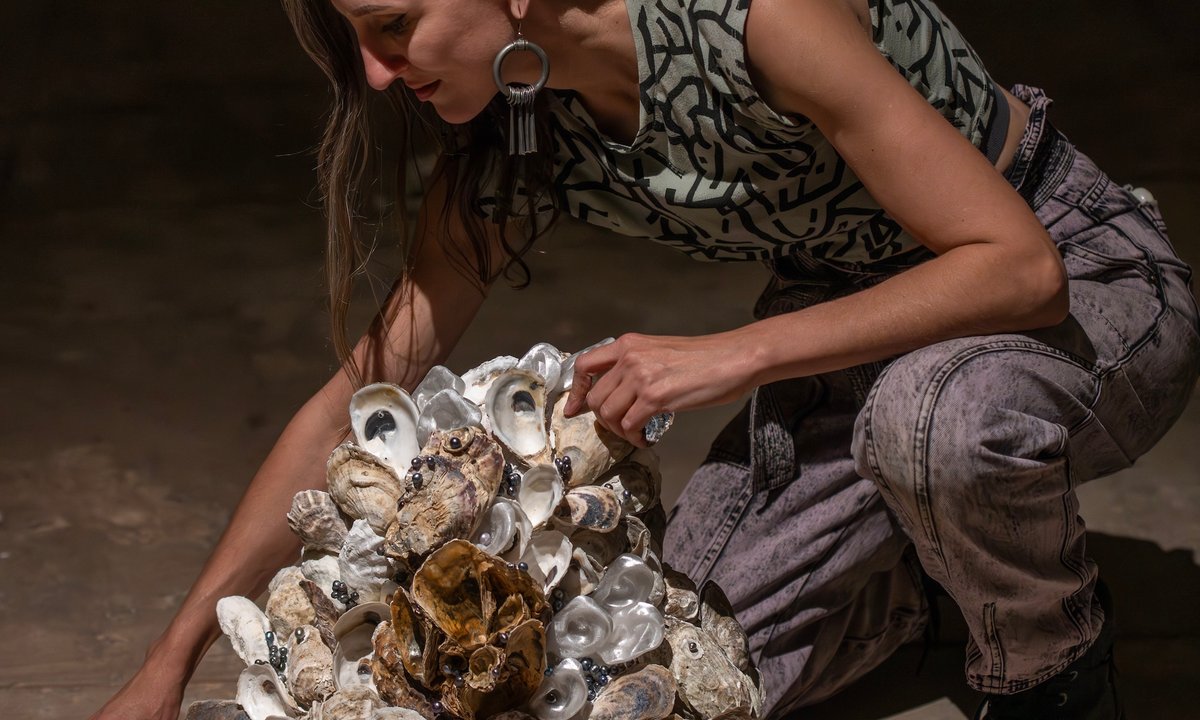The sound of whales singing echoes through a dimly lit, cavernous space on New York City’s Governors Island—a 172-acre island and public park just south of Manhattan formerly used for military purposes. A sonic installation, the songs are part of a site-specific public exhibition by the artist and climate activist Jenny Kendler. Centred on oysters and whales, Other of Pearl (until 31 October) considers the relationships between the human and non-human and underscores the impact of extractive practices on the climate crisis.
Presented by Governors Island Arts and the Natural Resources Defense Council (NRDC), Other of Pearl is installed in a magazine below the island’s Fort Jay, creating the feeling that the visitor has descended underwater. In addition to the whale recordings, which were provided by David Gruber of Project Ceti (the non-profit seeking to decipher whale communication), the exhibition features pearl sculptures grown inside oysters, antique glass vials of whale oil (a material exploited for purposes including lighting lamps and lubricating machines) and an installation of bells with fossilised whale ear bones made in collaboration with Andrew Bearnot that are rung periodically throughout the day.
Visitors can also sing back to the whales through glass instruments that emit the marine mammals’ recordings. “If we can imagine we might be able to speak to a creature, maybe we can feel closer to them,” Kendler says. “Oysters and whales are at opposite ends of a spectrum. Whereas whales can be seen as relatable, we don’t know if oysters have anything akin to a brain as we understand it. I hope viewers can tap into their animal bodies to feel open to these relationships as well.” The exhibition contains a model of the artist’s own nervous system made of thousands of tiny pearls strung together.
“Jenny addresses the climate crisis with experimental processes that can turn recognisable materials on their head,” says Lauren Haynes, the head curator and vice president for arts and culture at the Trust for Governors Island—the non-profit responsible for the island’s planning, operations and development. “She works in a way that welcomes visitors to rethink how the climate crisis exists in their daily lives, and how they might be able to engage with climate activism as well.”
Jenny Kendler and Andrew Bearnot’s Whale Bells (2019-ongoing) Photo: Julienne Schaer
Understanding the impact of extractive practices is at the heart of the show. New York Harbor, in which Governors Island sits, offers a poignant example. The area once fostered a rich, biodiverse ecosystem teeming with marine animals, including oysters and whales. Oysters are crucial in supporting a healthy ecosystem; an adult oyster can filter up to 50 gallons of water each day. Overconsumption and pollution led to the decline of oysters, and the whaling industry nearly decimated the giant mammals.
“Whales and oysters were both almost pushed off the face of the planet,” Kendler says. “I am interested in working against this premise that we can use others—human or non-human—as a fungible resource. This notion is a poison at the heart of our culture. Thankfully, now we’re seeing efforts to restore these species, which is an important part of the story as well.” After Other of Pearl closes, Kendler’s oyster-pearl sculptures will be sold at auction to support the Billion Oyster Project, a non-profit based on Governors Island working to restore New York Harbor’s oyster reefs and educate the public.
In considering its extractive history, Kendler also reflects on the legacy of the island itself. Originally Lenape territory, the land served as a home to early Dutch settlers, then changed hands between the British and Americans until after the Revolutionary War. Over the next two centuries, the island became an outpost for the army and then the coast guard. The magazine under Fort Jay was used to store ammunition, and the fort was transformed to hold prisoners of war during the American Civil War. Now, Governors Island hosts a national park as well as arts and culture events and organisations, and it will be the future site of the Center for Climate Solutions.
Kendler’s show was informed, in part, by the island’s relatively new role as an artistic hub. “Artmaking can be a practice of ecological remediation,” she says. “We can heal a site through artmaking. This is what I’m trying to show—that we can restore our kinship with the more-than-human world.”
- Other of Pearl, Governors Island, New York, until 31 October

